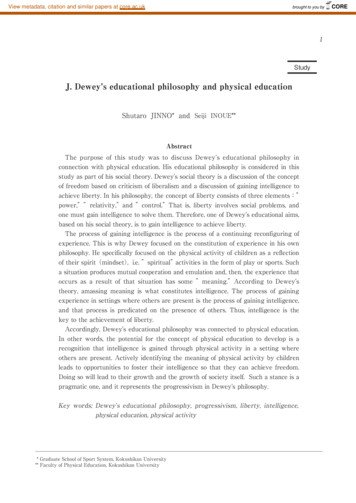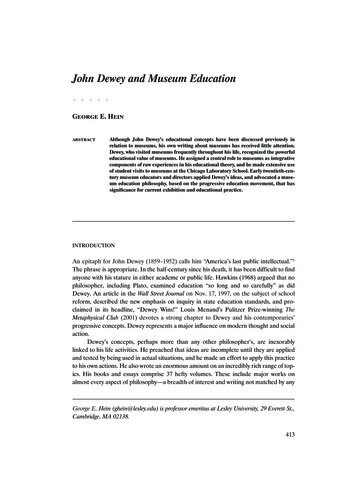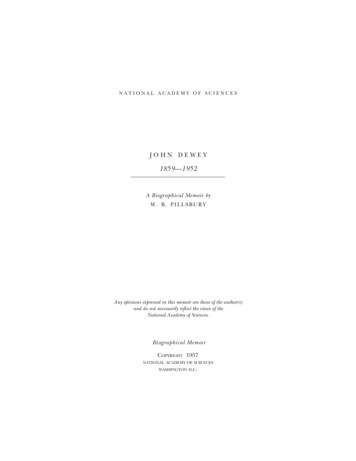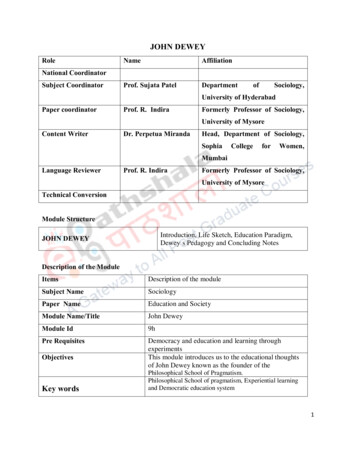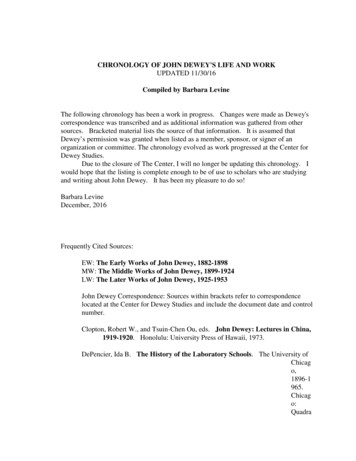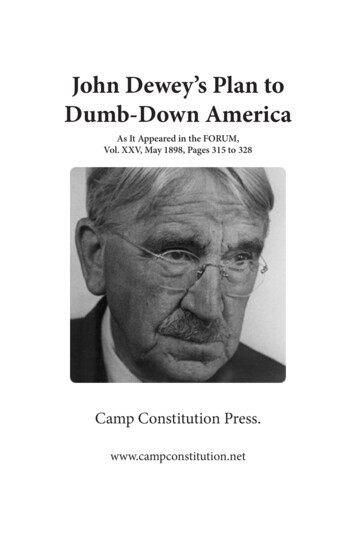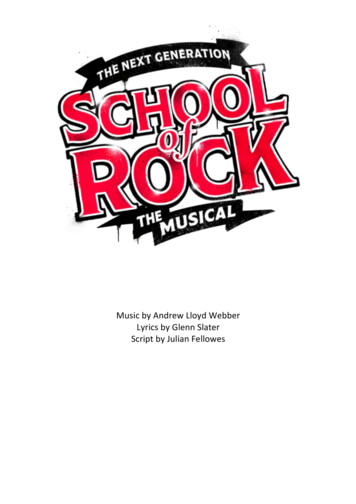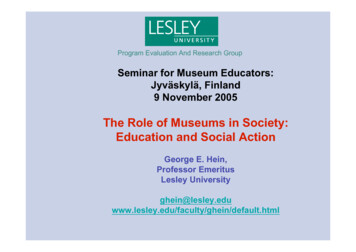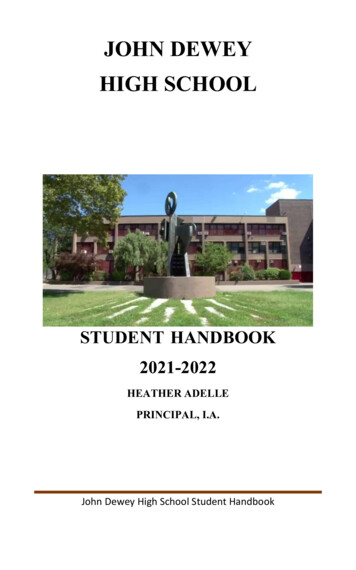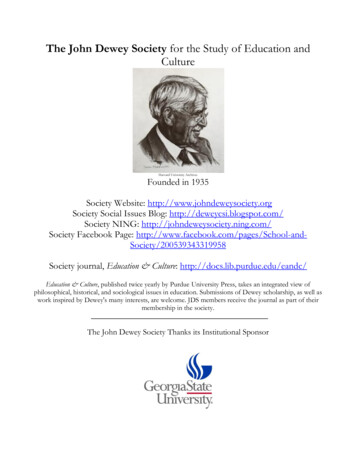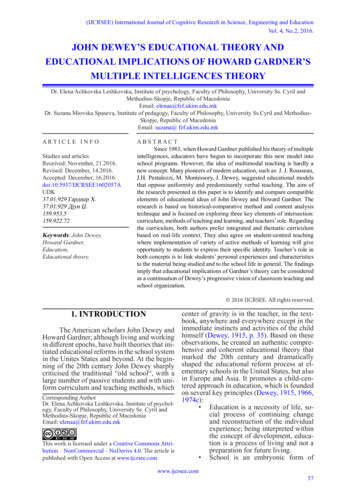
Transcription
(IJCRSEE) International Journal of Cognitive Research in Science, Engineering and EducationVol. 4, No.2, 2016.JOHN DEWEY’S EDUCATIONAL THEORY ANDEDUCATIONAL IMPLICATIONS OF HOWARD GARDNER’SMULTIPLE INTELLIGENCES THEORYDr. Elena Achkovska Leshkovska, Institute of psychology, Faculty of Philosophy, University Ss. Cyril andMethodius-Skopje, Republic of MacedoniaEmail: elenaa@fzf.ukim.edu.mkDr. Suzana Miovska Spaseva, Institute of pedagogy, Faculty of Philosophy, University Ss.Cyril and MethodiusSkopje, Republic of MacedoniaEmail: suzana@ fzf.ukim.edu.mkARTICLE INFOStudies and articlesReceived: November, 21.2016.Revised: December, 14.2016.Accepted: December, 16.2016.doi:10.5937/IJCRSEE1602057AUDK37.01:929 Гарднер Х.37.01:929 Дјуи Џ.159.953.5159.922.72Keywords: John Dewey,Howard Gardner,Education,Educational theory.ABSTRACTSince 1983, when Howard Gardner published his theory of multipleintelligences, educators have begun to incorporate this new model intoschool programs. However, the idea of multimodal teaching is hardly anew concept. Many pioneers of modern education, such as: J. J. Rousseau,J.H. Pestalozzi, M. Montessory, J. Dewey, suggested educational modelsthat oppose uniformity and predominantly verbal teaching. The aim ofthe research presented in this paper is to identify and compare compatibleelements of educational ideas of John Dewey and Howard Gardner. Theresearch is based on historical-comparative method and content analysistechnique and is focused on exploring three key elements of intersection:curriculum, methods of teaching and learning, and teachers’ role. Regardingthe curriculum, both authors prefer integrated and thematic curriculumbased on real-life context. They also agree on student-centred teachingwhere implementation of variety of active methods of learning will giveopportunity to students to express their specific identity. Teacher’s role inboth concepts is to link students’ personal experiences and characteristicsto the material being studied and to the school life in general. The findingsimply that educational implications of Gardner’s theory can be consideredas a continuation of Dewey’s progressive vision of classroom teaching andschool organization. 2016 IJCRSEE. All rights reserved.1. INTRODUCTIONcenter of gravity is in the teacher, in the textbook, anywhere and everywhere except in theThe American scholars John Dewey and immediate instincts and activities of the childHoward Gardner, although living and working himself (Dewey, 1915, p. 35). Based on thesein different epochs, have built theories that ini- observations, he created an authentic compretiated educational reforms in the school system hensive and coherent educational theory thatin the Unites States and beyond. At the begin- marked the 20th century and dramaticallyning of the 20th century John Dewey sharply shaped the educational reform process at elcriticised the traditional “old school“, with a ementary schools in the United States, but alsolarge number of passive students and with uni- in Europe and Asia. It promotes a child-cenform curriculum and teaching methods, which tered approach in education, which is foundedon several key principles (Dewey, 1915, 1966,Corresponding Author1974c):Dr. Elena Achkovska Leshkovska. Institute of psychol Education is a necessity of life, soogy, Faculty of Philosophy, University Ss. Cyril andcial process of continuing changeMethodius-Skopje, Republic of Macedoniaand reconstruction of the individualEmail: elenaa@fzf.ukim.edu.mkexperience; being interpreted withinthe concept of development, education is a process of living and not aThis work is licensed under a Creative Commons Attripreparation for future living.bution - NonCommercial - NoDerivs 4.0. The article is School is an embryonic form ofpublished with Open Access at www.ijcrsee.comwww.ijcrsee.com57
(IJCRSEE) International Journal of Cognitive Research in Science, Engineering and EducationVol. 4, No.2, 2016. community life and an instrumentfor social change and progress. Thatmeans that the school life grows outof all the aspects of the social lifeand that the child’s experience develops in transaction with the community he lives in.Activity is the fundamental characteristic of the child’s nature, whichis expressed through his instincts,experience, interests and individuality. They represent a huge educational potential and starting point ofthe process of learning, but are notan end in itself: they need to be controlled and guided toward realization of predetermined goals.Eight decades after Dewey had announced his educational theory, Gardner(1983) introduced the theory of multiple intelligences (MI), challenging the traditional concept of general intelligence as a single entity.On the basis of the neurological and culturalresearch, he described an individual’s cognitive abilities in terms of seven relatively independent but interacting intelligences: linguistic, logical-mathematical, spatial, musical,bodily-kinesthetic, intrapersonal and interpersonal. Later he added the eight, naturalistintelligence, and considered the possibility ofincluding existential one as a ninth. The keypoints of the concept are: 1. each person possesses all intelligences, but they function together in ways unique to each person; 2. mostpeople can develop each intelligence to anadequate level of competency; 3. intelligencesusually work together in complex ways and 4.there are many ways to be intelligent withineach category (Armstrong, 1994).Gardner himself offered very few suggestions for educational use of the MI theory,since psychology does not directly dictateeducation but, “it merely helps one to understand the conditions within which educationtakes place” (Smith, 2002, 2008). However,it has had an intense impact on educationalpractice and during the late 80’s a number ofschools in North America have structured curricula according to its key principles. The theory inspired educators to question their workand encouraged them “to suggest approachesto curriculum, pedagogy, assessment, learning differences, use of computers, place of thearts—indeed, almost any issue in which educators are interested” (Gardner, 2011, p. 6).The experience of scholars and practitionerson implementation of MI ideas with various58populations, age groups and educational settings was presented in the book Multiple Intelligences Around the World (2009). Of course,along with the good practices, a lot of misinterpretation occurred, that provoke the authorto delineate the most common misunderstandings of his theory (Gardner, 1993, p. 68).Although Gardner didn’t create educational theory, he reflected on the differenttrends and contemporary status of the education in American society. In this context,he emphasized the need of changing theAmerican education toward student-centredteaching: “American education is at a turning point. There are considerable pressuresto move very sharply in the direction of “uniform schooling”; there is also the possibilitythat our educational system can embrace “individual centred schooling” (Gardner, 1993,p. 68). Gardner himself declared that muchof his writings on education have been identified with educational tradition of Deweyand so called progressive or neo-progressivemovement. He accepted his “alternative educational vision” which is “centred on understanding” so that “an individual understandsthe concept, skill, theory or domain of knowledge to the extent that he or she can apply it toa new situation” (Gardner, 1999, p. 118-119).In fact, Dewey and Gardner shared the sameneed for educational reform claiming that theestablished teaching methods at their timesare neither correct nor beneficial for students.Also, both authors’ ideas were subject to criticism and unenthusiastic responses along withthe positive reactions.2. MATERIALS AND METHODSThe review of the part of the literaturewritten by Howard Gardner and other authorswho overview his ideas and their educationalimplication, shows that on several occasionsthe relation between Dewey’s and Gardner’sthoughts on education has been pointed out.Unfortunately, either the elaboration on theircommon ideas is missing, or there are irreconcilable interpretations of Dewey’s influenceon Gardner. For example, Armstrong (1994)wrote that “MI theory is perhaps more accurately described as a philosophy of education,an attitude toward learning, or even a metamodel of education in the spirit of John Dewey’s ideas.”. Berube and Berube (2007, p.21) declared that “Howard Gardner is anotherneo-progressive with links to John Dewey.Moreover, Gardner’s definition of intelligencewww.ijcrsee.com
(IJCRSEE) International Journal of Cognitive Research in Science, Engineering and EducationVol. 4, No.2, 2016.is a variation of Dewey’s.”The lack of analysis of the statements asthose mentioned above was the incentive forthe study aiming at: presenting J. Dewey’s key ideas oneducation; presenting key points of implicationsof H. Gardner’s MI theory in educationalpractice; identifying and comparing compatibleelements of educational ideas of John Deweyand Howard Gardner.The method used in the research ishistorical-comparative and it is carried outthrough content analysis of several books andscientific papers of both authors, as well as thepart of the literature that comment their work.The analysis is focused on exploring three keyelements of intersection of both authors’ educational ideas: curriculum, methods of teaching and learning, and teachers’ role. The material that is subject to analysis is presented inthe list of references.2.1. Dewey and Gardner’s ideas:comparing key educational conceptsCurriculumDewey on CurriculumCurriculum represents central issue inDewey’s school and key concept in his educational theory. If the starting point is the childwho creates his experience in transaction withthe surrounding environment, it is understandable why Dewey’s concept of curriculum isdifferent from the traditional one, which isperceived as a set of systematized informationthat is carefully packed in subjects and is independent from the child’s experience. Hence,traditional school is separated from the real lifeand becomes “place for listening”; the knowledge becomes formal, static, and dead, whilethe child is treated as immature, superficial being with egoistic, impulsive and confused behaviour. Despite the fact that Dewey criticizedtraditional separation of the curriculum fromchild’s experiential learning, he didn’t rejectthe idea of systematized knowledge. The education should follow the path that leads fromchild’s individual experience towards cumulative experience of the human kind. In thisway, the child and the school curriculum buildtogether the unity of the educational process.Dewey pays great attention to the relationship between the child and the curriculum,trying to overcome the separation between thetwo fundamental factors in the educationalprocess, between “an immature, undevelopedbeing and certain social aims, meanings, values incarnate in the matured experience of theadult” (Dewey, 1974a, p. 339-340). This separation leads to three fundamental divergencesand elements of conflict: the narrow but personal world of the child against the impersonal but infinitely extended world of space andtime; the unity, the single wholeheartednessof the child’s life, and the specializations anddivisions of the curriculum; an abstract principle of logical classification and arrangementand the practical and emotional bonds of childlife (Dewey, 1974a, p. 341-342). According toDewey, these differences are the basis for developing two opposing educational systems:subject-centered and child-centered education. He strives to unify them, emphasisingthat there is no gap, but a transaction betweenthe child and the subject matter, because theyare simply two limits which define a singleprocess: “Just as two points define a straightline, so the present standpoint of the child andthe facts and truths of studies define instruction. It is continuous reconstruction, movingfrom the child’s present experience out intothat represented by the organized bodies oftruth that we call studies” (Dewey, 1974a, p.344). Hence, it is obvious that Dewey is notagainst the organized knowledge in textbooksand curriculum, but that it represents an aimof the learning process, the “final point” thatshould be reached. Human experience presented in books and textbooks is of great importance for the child, because it “gives direction; it facilitates control; it economizes effort,preventing useless wandering, and pointingout the paths which lead most quickly andmost certainly to a desired result” (Dewey,1974a, p. 350). However, the subject matteris not a substitute for a personal experience,for “an actual journey”. It has meaning onlyif related to the existing experience, providingits stimulation and guidance. The absence ofthis characteristic, according to Dewey, causesmany weaknesses of the traditional school.When learning is based on experience,it is characterized by continuity and interaction. Unlike the old school where subjects aretaught independently of each other in strictlydefined time frames, Dewey stands for connection of subject content and flexible duration of classes, allowing the child to follow hisinterest in the process of learning. Basic skillssuch as reading and writing, in his opinion,should not be taught as formal subjects, butwww.ijcrsee.com59
(IJCRSEE) International Journal of Cognitive Research in Science, Engineering and EducationVol. 4, No.2, 2016.should result from the child’s need to masterthem in order to realize new goals. They represent instruments that every child learn how touse them, in his own pace in accordance withthe individual motivation.In the last years of the 19th century,Dewey observed that “the accumulation ofknowledge has become so great that the educational system is disintegrating through thewedges of studies continually introduced”(Tanner, 1997, p.163). The answer to theseconditions he finds in developmental curriculum: “All studies arise from aspects of the oneearth and the one life lived upon it. We do nothave a series of stratified earths, one of whichis mathematical, another physical, another historical, and so on Relate the school to life,and all studies are of necessity correlated”(Dewey, 1915, p. 80-81). Therefore, startingpoint for teachers in Dewey’s school is undifferentiated curriculum that is followed bybuilding conceptual knowledge from differentsubject arias. What provides the unity of thecurriculum and its horizontal and vertical connection are occupations, which keep balancebetween intellectual and practical phase in theexperience.Gardner on curriculumOne central question in education isWhat is to be taught? Is it most important tofocus on societal roles, cultural values or various forms of knowledge accumulated over themillennia? Each society value specific capacities and knowledge is encoded in variety offorms. Achieving an appropriate balance of“skilled performance, rich information anddeep understanding” is a challenging matter(Gardner, 1991, p. 118). Gardner’s interest in‘deep understanding’, performance, exploration and creativity are not easily accommodated within an orientation to the ‘delivery’ of adetailed curriculum planned outside of the immediate educational context. He is convincedthat superficial understandings of learners dueto the fact that schools attempt to cover a largequantity of material. Instead, it is far moreuseful to spend more time on key concepts andessential questions and to allow students tobecome familiar with these notions and theirimplications.The linking of students’ education withthe most up-to-date ‘facts’ about human intelligence, has great implications for the schoolsetting. Gardner admits that “the idea of a number of relatively independent cognitive abilities is not in itself daunting. What is daunting60is the notion that one should therefore changeone’s pedagogy, curriculum, or means of assessment” (Phillips, 2010, p. 5). MI theorybased curriculum is student-centered, flexible(full of choices) and provide a setting for learning that is hand-on, interdisciplinary, based onreal-life contexts, and set in an informal atmosphere that promotes free inquiry into novelmaterials and situations. Gardner (1999, p.221) wrote: “Without apology, I confirm thatI am a defender of the disciplines” but delivery of the traditional school subjects should bedone in non-traditional ways, through projectcentred instruction and extension of students’understanding of the topic by activities in thelocal community. Thematic and integrative instruction imitates life because it teaches students from an interdisciplinary point of viewand provides them with opportunities to usetheir multiple intelligences in practical ways.As a proponent of pluralistic approach,Gardner claims that nearly every topic canbe approached in several ways: telling of astory, an artistic exploration, experiment orsimulation. Since some individuals learn better through stories, others through artisticexpression, or hands on activities or groupwork, each of these approaches activates adistinctive set of intelligences. Approachinga topic from a number of perspectives can bedescribed as “multiple windows leading intothe same room.” The benefit of pluralization isthat more learners will be able to understandsomething well, in ways that are comfortablefor them and “not to leave any student out ofthe learning loop like the traditional schooling has done” (Phillips, 2010). Because themodel is flexible, how it is applied in schoolswill vary depending on the beliefs and goals ofeducators. The author of the MI theory statesthat it is not a collection of rigid scripts thatschools must enact in the same way in all settings, nor is it a simplistic cookbook for schoolimprovement; “there are as many plausiblerecipes as there are educational chefs” (Achkovska Leshkovska, 2002, p. 101). However,Gardner (1995, p. 9) pointed out that he wouldappreciated school where “differences amongyoungsters are taken seriously, knowledgeabout differences is shared with children andparents, children gradually assume responsibility for their own learning, and materials thatare worth knowing are presented in ways thatafford each child the maximum opportunityto master those materials and to show others(and themselves) what they have learned andunderstood.”www.ijcrsee.com
(IJCRSEE) International Journal of Cognitive Research in Science, Engineering and EducationVol. 4, No.2, 2016.Dewey and Gardner on curriculumOn the basis of presented ideas of Dewey and Gardner on curriculum, it is possible toidentify several common points of view. Bothauthors claim that the subject matters shouldprovide links with real-life situations in orderstudents’ knowledge to be useful. The starting point of both authors is the child’s natureand the need to adjust the curriculum to itsindividual features. While Dewey is focusedon child’s present experience and interests asembryos of capacities, Gardner put emphasis on distinctive cognitive profiles that aredeveloped in early childhood and determinethe most effective “entry points” for learning.Students’ individual differences that are highlighted in Dewey’s and Gardner’s views, pavethe way for flexible curriculum that is set up inan informal atmosphere. According to Dewey,the individualization of the curriculum is donethrough certain real-life occupations as formsof experiential learning and practical “learning-by-doing” activities. On the other hand,individualization within the educational implications of Gardner’s MI theory is achievedthrough translation of the content into different “language” of each intelligence.Another meeting point in Dewey’s andGardner’s views is integrated curriculum.Gardner relates the implementation of thiskind of curriculum to the child’s need to get“an overall sense of the world”, to integratedifferent channels of the own complex of intelligences, “for survival could not take placein the absence of some coherent versions ofthe world” (Gardner, 1991, p. 83). Close tothis is Dewey’s developmental curriculumthat is undifferentiated, because it reflects theprimitive unconscious unity of the social lifeof the child. Unlike Gardner who is not explicitly against division of knowledge in differentsubjects, Dewey argues that it is a violationof the child’s nature if introducing the childtoo abruptly to a number of specific studies.The student’s progress is not “in the succession of studies, but in the development of newattitudes towards, and new interest in, experience’’ (Dewey, 1974c, p. 434).2.2. Learning and teaching methodsDewey on learning and teaching methodsAccording to Dewey, the method is always in relation with the subject matter, itis not something outside of the material thatneeds to be studied. The method is “the effective direction of subject matter to desiredresults” (Dewey, 1966, p. 165), and the effectiveness implies processing of the contentwith maximum of savings in time and energy. This means that the method is primarily work of mind in dealing with experientialcontent: “The only method that has meaningis the method of the mind that achieves andassimilates” (Dewey, 1966, p. 127). Hence,when talking about method, Dewey puts emphasis not so much on teaching methods, buton methods of learning and experiencing.In the process of learning by experience,Dewey says, the starting point is a particularproblem situation, because the problem itself isthe provocative element in the experience thatcalls upon the mind and puts it into operation.Having in mind that the development dependson the exposure to difficulties that should beovercome through the engagement of mind(Dewey, 1966b, p. 79), Dewey believes thatthe key method in the process of learning isproblem solving. Problem situations shouldbe connected to actual child experience andwithin the child’s abilities for their resolution.Since earliest ages, children work on projects,individually or in groups, in school laboratories that enables them to develop their intelligence and manipulative skills. The aim ofsuch an activity is not to give students analytical knowledge about the subject, but to stimulate their curiosity and research spirit (processoriented instead of content-oriented). Hence,learning methods should be active and inquirybased and the accumulation of informationand principles must be subordinated to the development of intellectual self-control and ability to identify and solve problems.Experience is the link between the method and the curriculum, between the action andthe object upon which it is acted. It is not onlya simple combination of mind and world, ofmethod and content, but it is “a single continuous interaction of a great diversity of energies”(Dewey, 1966, p. 167). Isolation of the methodand the content, according to Dewey, leads toseveral anomalies in the school educationalprocess. Considering the fact that the studentshave very few opportunities for experientiallearning, methods that teachers use are not anexpression of their own “intelligent observations,” but are “authoritatively recommended”and are characterized by “a mechanical uniformity “ (Dewey, 1966, p. 168). This meansthat the method becomes a cut and dried routine of following prescribed steps, rather thanwww.ijcrsee.com61
(IJCRSEE) International Journal of Cognitive Research in Science, Engineering and EducationVol. 4, No.2, 2016.a creative act and a result of an individual experimentation.Teaching method, says Dewey, is themethod of an art, of action intelligently directed by ends (Dewey, 1966, p. 170). As everyartist should be thoroughly acquainted withmaterials and tools with which he works, sothe teacher must be in possess of the methodsused by others, which experience has shownto be more efficient in the process of acquiring knowledge. However, knowing or owningthese, as Dewey calls them, general methods,is not in opposition to the individual initiative and creativity of the teacher. If they areacquired as intellectual aids in sizing up theneeds, resources, and difficulties within theframework of his experience, they are of constructive value (Dewey, 1966, p. 172). At thesame time, the method is a result of the individual’s specificity and could be understand asvarious individual methods. They reflect theindividual approach to the problem, as wellas different abilities, past experiences and interests. Dewey believes that there are severalattitudes that are central in the process of intellectual dealing with subject matter: directnessor straightforwardness with which one goes atwhat he has to do, flexible intellectual interestor openness of mind for learning, intellectualintegrity, honesty and sincerity, as well as undertaking responsibility for the consequencesof the act (Dewey, 1966, p. 173-179).In Dewey’s educational theory, the issue of method is primarily an issue of development of child’s powers and interests. Itmeans that the teacher should know well eachchild’s development and follow his interestswhich are understood as “dawning capacities”(Dewey, 1974c, p. 436). In fact, the methodand the way the content will be processed, isto be found in the child’s own nature. Thus,considering the fact that the active side precedes the passive in the development of thechild’s nature (“expression comes before conscious impression; the muscular developmentprecedes the sensory; movements come beforeconscious sensations .” (Dewey, 1974c, p.435), it is necessary to create conditions in theprocess of education that will allow the childto express its nature regarding the content, aswell as the methods of learning and teaching.but they function together in ways unique toeach person. Children begin to show inclinations in specific intelligences from an earlyage and by the time they enter the school, theyhave already established ways of learning thatare in line with their preferred intelligences.Each intelligence has its own unique symbolor notational system: phonetic, idegraphic,musical notational system etc. Therefore,there is absolutely no reason to teach and assess all individuals in the identical way.According to Gardner (2011), the mostimportant educational implications of MI theory are individuation and pluralization. Noting that the traditional classrooms stimulatedominantly linguistic and logical-mathematical abilities, Gardner emphasizes the need toexpand teachers’ repertoire of strategies withones that nurture each intelligence. Studentsthink and learn in many different ways. Using different methodologies, exercises andactivities, teachers will meet needs of all students, not just those who excel at linguisticand logical intelligence. The broad range oftechniques provides each student, from timeto time, to have opportunity to learn in a waythat works best for him/her. However, selection of appropriate methods should be basedon solid criteria and critical inquiry on the partof the teacher.Gardner (2011, p. 6) suggested that “inthe future, good practice should particularize the modes of presentation as well as themanner of assessment as much as feasible;and that individuation should be based on ourunderstanding of the intellectual profiles ofindividual learners.” Gardner recognizes thatit is hard to implement individualization inclassroom with large number of students, butin a modern era a learner-centered curriculumis more readily attained because of the availability of computer technology in educationsettings. Schools can deliberately collect andmake available resources- human and technological -that fit comfortably with the disparatelearning style and cultural background of eachstudent. (Gardner, 1991, p. 244).Gardner himself didn’t come up witha set of teaching strategies that promote MIphilosophy. Rather, the theory offers educatorsa broad opportunity to creatively adapt its fundamental principles to different educationalGardner on learning and teachingsettings. Some of the teaching techniques havemethodsbeen used for decades by good teachers, theother ones are invented by the teachers themOne of the basic principal in MI theory is selves. For example, Armstrong (2009) elabothat human beings differ from one another and rates forty teaching strategies, five for eacheach person possesses all eight intelligences, of the eight intelligences that are designed to62www.ijcrsee.com
(IJCRSEE) International Journal of Cognitive Research in Science, Engineering and EducationVol. 4, No.2, 2016.be general enough to be applied at any gradelevel.Dewey and Gardner on learning andteaching methodsBoth authors share same understandingof methods of learning and teaching as tools fordevelopment of child’s strengths and interests.The method is implicit within the child’s ownnature, hence it is necessary for the teacher touse a variety of methods that are complementary to the topic and to the student’s specificcognitive style and identity. They also agreethat learning should not be primarily orientedon products, but on process, and therefore,teachers should use methods that provoke student’s higher order thinking instead of merememorizing the facts.Unlike Dewey who elaborates the issueof method on a solid theoretical basis, makingdistinction between general and specific methods and focusing on problem solving situations in the process of learning, Gardner offersonly general guidelines that enable teachers tocreate a vast range of techniques that encourage development of different intelligences. Hisstarting point is that traditional teaching givespriority to methods that stimulate linguisticand mathematical-logical intelligences, andthe result is that many students fail to exhibittheir strengths in other domains.2.3. Teacher’s roleDewey on teacher’s roleThe role of the teacher in Dewey’s educational theory is defined within the framework of its understandings of experience and
The American scholars John Dewey and Howard Gardner, although living and working in different epochs, have built theories that ini-tiated educational reforms in the school system in the Unites States and beyond. At the begin-ning of the 20th century John Dewey sharply critici
